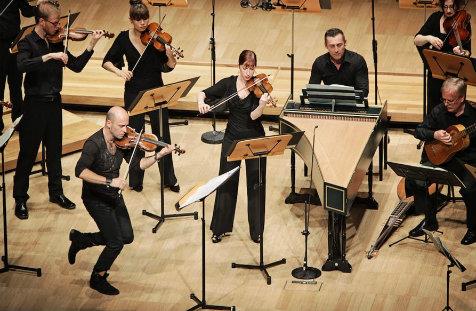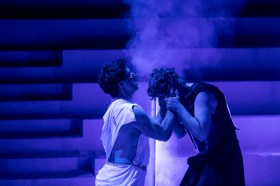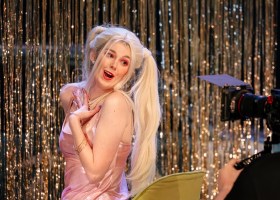The title of this concert gave a clear indication of several things: there was a strong Italian connection, the music would be exuberant – and the performers were likely to be from the Australian Brandenburg Orchestra. On the night (as at every performance on this national tour) the picture was completed.
The program comprised concertos by Veracini, Brescianello and Geminiani, as well as Brandenburg audience favourites, Handel and Telemann. Joining the ABO and its artistic director, harpsichordist Paul Dyer, was guest director Stefano Montanari, also playing solo baroque violin.
Dyer briefly addressed the audience to tell of his meeting with Montanari in Bergamo, Italy, that – as with many of Dyer’s enviable travels – proved to have artistic, architectural and historic delights (as well as musical connections, good company, and no doubt, memorable food and drink!).
Montanari brought his own part of European history with him, in the shape of a Hendrick Jacobsz violin, made in Amsterdam in 1680 and reputedly once owned by the celebrated French poet Alfred de Musset.
Back to the musical feast that was served up for us. Montanari acknowledged enthusiastic applause, but soon turned to the ensemble for a concerted approach to the opening work, the first movement of Veracini’s Concerto a otto stromenti in D major. (This composition book-ended the concert, with the second and third movements later rounding off the night).
Embellished with trumpets, winds and drums, the work instantly gave credence to the title of the concert. Montanari’s style was all-embracing so that he had kept these elements together – but turned to face the audience when brilliantly executing the composer’s demands for quadruple stopping and fast runs at the top of the violin range.
According to the program notes Veracini himself was a brilliant, possibly crazed, violinist who, at a concert once called out ‘This is the way to play the first violin,’ to another eminent violinist. This would certainly not have been needed in a Montanari performance!
At first it appeared the audience may have been short-changed with the program listing only vivace and allegro movements for Handel’s Concerto grosso in D major Op.3 No.6. However, unusually, the complete work consists of just these two movements. What it lost in length the concerto gained in spirit, beginning with the strings playing arpeggios in unison (a recurring theme). Also to the fore at various points were the oboes, bassoon, harpsichord and a violin solo for Montanari. With so many soloists the work was a fine example of the concerto grosso form that preceded the concept of the single soloist.
Handel’s Italian contemporary Brescianello, however, gave great prominence to the solo violin in his Concerto No.4 in E minor, and was a superb vehicle for Montanari’s prowess. Even more stunning than the technically demanding allegros was the middle andante, reminiscent of slow movements in Vivaldi’s Four Seasons, played with sweetness and strength by this master of his instrument.
Chaconne in A major, also by Brescianello, allowed the audience to recover from the emotional intensity of the concerto thanks to its light-hearted dance form. More than just a courtly diversion, it continued the pattern of highlighting instruments within the orchestra, as well as Montanari.
It has to be said that, as a director, the visitor took every opportunity to share the limelight, drawing the audience’s attention to individuals and sections that had the most important parts in each work. This was a pattern – mixed with Montanari’s own brilliant playing – that continued after interval.
The opening work, Telemann’s Concerto in E minor for flute, violin and strings TWV 52:e3, introduced another soloist: Melissa Farrow, playing baroque flute. Farrow proved a match for both the violin solo – and the strings section that kept the pace brisk in the opening movement, and sweetly melodic in the second. All players met the challenge of the presto before the final harmonious adagio led to a brisk final allegro that recalled the opening movement.
Geminiani had decreed that his music for the Concerto grosso No.12 in D minor La Follia ‘should sing’ – and it did, sonorously. The theme was in the form of a slow, stately dance, after which 22 variations put Montanari and the ABO through their paces, fast tempi alternating with more reflective sections.
In that way it was a model for the whole program. It grew on two great strengths of many baroque concertos: well-coordinated rhythmic first and later movements, with the violin particularly important in expressive slow movements. A return to the Veracini concerto gave further examples of these baroque qualities. The solo violin featured in a beautiful, rich largo with extraordinary accidentals until a brief resolution in the major key before segueing into the final allegro.
Superb playing was heard from all: trumpets, theorbo, oboes and perfectly judged strings, to name some. Two encores – Corelli’s Concerto Grosso Op.6 No.4 (adagio and allegro) and the andante from Vivaldi’s Violin Concerto RV 222 – rounded off a memorable evening of simply superb playing.
As guest director Montanari called players up to take their bows, and seemed as proud of the ensemble’s performance as he must surely have been of his own leading part in it.
Rating: 4 ½ stars out of 5
Celebrazione!
Australian Brandenburg Orchestra
Artistic Director Paul Dyer
Stefano Montanari (Italy): guest director and baroque violin
Melissa Farrow (Australia): baroque flute
Veracini – Concerto a otto stromenti Movement 1 only
Handel – Concerto grosso D, Op. 3/6 HWV 317
Brescianello – Concerto No. 4 in E minor & Chaconne in A major
Telemann – Concerto in E minor for flute, violin and strings TWV 52:e3
Geminiani – La Follia
Veracini – Concerto a otto stromenti 2nd & 3rd Movement
Melbourne Recital Centre
27 July






